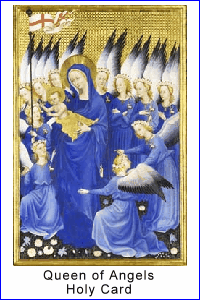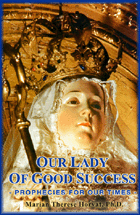Faith under Attack
 |
 |
 |
 |
 |
 |
 |
The Museum of the Poor Souls in Purgatory - II
After viewing some of the exhibits in the Museum of the Poor Souls in Purgatory in Rome, several readers asked me how a Poor Soul, a pure spirit, could appear in body to persons on earth and leave behind concrete proof of their suffering.
There is no great difficulty in explaining how the souls of the dead (whether blessed in Heaven, suffering in Purgatory or damned in Hell) can appear in bodily form on earth. The Church teaches that, with God’s permission, a spirit can assume some material substance in order to represent itself to the human eye, whether that substance be a body or light rays or some kind of cloud or vapor. (1)
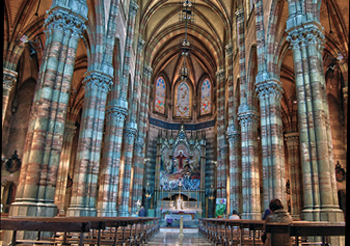
Inside the Church of the Sacred Heart of Suffrage in Rome
Thus we have artifacts like those in the Small Museum, duly approved by the Church, that resulted from apparitions of Poor Souls who were allowed to return to earth to solicit prayers, ask for Masses or warn their loved ones to change their lives.
What the Church prohibits is to try to enter into contact with the souls of the dead, as Deuteronomy warns us: Let no one be found among you who practices divination or sorcery, interprets omens, engages in witchcraft or casts spells, or who is a medium or spiritist or who consults the dead. (18:10-11) The Church teaches us that, under these circumstances, the Devil – also a pure spirit – can take on bodily forms in order to deceive those who follow such practices. Because it is so easy to be fooled, the faithful must exercise extreme caution in any matter dealing with apparitions of spirits or invoking them to appear.
In my last article, I promised to continue the tour of the Small Museum of Poor Souls on the Lungotevere neighborhood in the Prati section of the street that runs parallel to the Tiber. So let me fulfill my promise by looking at several more interesting exhibits.
A handprint burned into wood
One of the most impressive exhibits is a rectangular slab of wood that displays two burn marks - a scorched hand mark and a sign of the cross. These marks were left on a small wooden table by the deceased Fr. Panzini, former Abbot on the Benedictine Olivetan Order in Mantua. On November 1, 1731, Fr. Panzini appeared to Ven. Mother Isabella Fornari, Abbess of the Poor Clares Monastery of St. Francis in Todi as she sat at her work desk. He told her he was suffering in Purgatory.
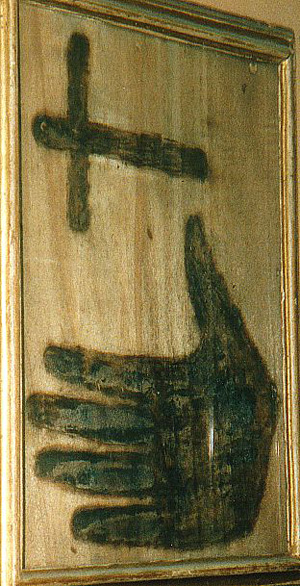
The handprint and cross left by Fr. Panzini
As evidence of his state, he placed his flaming left hand on the table top and left a hand mark, and then he etched a cross on it with his finger. Before he disappeared, he touched the sleeve of her tunic with his right hand, leaving a burn mark on the tunic that passed through it to the chemise, all the way to the flesh. There is a clear mark on the chemise, which is stained with blood from the burn Mother Fornari received. The tunic and chemise are displayed in another exhibit.
The Abbess reported this visit to her confessor, Fr. Isidoro Gazata, a Holy Cross father. He wrote a report and ordered her to cut from her tunic and chemise the parts where the burn marks were made and to give them to him to keep. He also preserved the tabletop with the scorched hand mark and cross. These artifacts were examined by theologians and other experts of the Diocese, and determined to be of supernatural origin.
When Fr. Victor Jouet began his search at the beginning of the 20th century to find evidence of vestiges left by the Poor Souls in Purgatory, the Monastery gave him all of these relics, which were duly authenticated and are now displayed in the Small Museum. This collection, as I noted in my previous article, was part of the legacy he left his Order of the Sacred Heart of Suffrage, which was founded with the aim of spreading the devotion to the Sacred Heart as a source of help to the souls in Purgatory, according to the revelations of St. Margaret Mary Alacoque.
Expiation for her lack of patience
On the night of June 5, 1894, the deceased Sister Maria of St. Louis Gonzaga, known for her piety, appeared to Sister Margherita, another nun in Poor Clares Convent of St. Clare in Bastia, Perugia. To the surprise of Sister Margherita, Sister Maria said that she was in Purgatory.
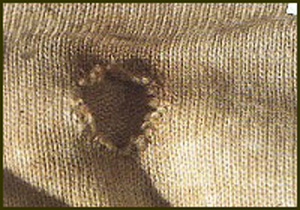
A close up of the scorch mark left on Sister Margherita's pillow
As recorded in the Convent annals, Sister Maria had been suffering greatly from tuberculosis, high temperature, coughs and asthma. She became depressed and prayed that she might die quickly so as not to endure such suffering. She died a holy death a few days later, on the morning of June 5, 1894.
It was that same night that she appeared to Sister Margherita dressed in her Poor Clare habit. Although the atmosphere around her was hazy, Sister Margherita could recognize her. Sister Maria told her that she was in Purgatory to expiate for her lack of patience in accepting God’s will, and she asked for prayers.
As a proof of her apparition, she placed her forefinger on the pillow of Sister Margherita, leaving a scorch mark, and promised to return. In fact, she appeared again to the same nun on June 20 and 25 to thank her for her prayers and to tell her she would be released from Purgatory. She also offered some spiritual advice for the community.
Fingerprints on a prayer book
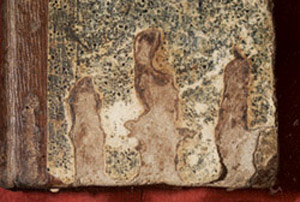
Three finger prints burned into the prayer book cover of Maria Zaganti
On March 5, 1871, Palmira Rastelli, who had died on December 28, 1870, appeared to her friend Maria Zaganti. She asked Maria to tell her brother, Fr. Sante Rastelli, to have Masses said for her soul because she was suffering in Purgatory.
Palmira left proof of her appearance by touching the cover of Maria's prayer book. Three scorched finger marks can be seen on it.
A place of fire and expiation
What is clear from these examples is there is a fire in Purgatory, as in Hell. But in Purgatory, the soul suffers with perfect resignation, knowing that it is heading to Heaven. Anna Katharina Emmerick (d.1824) had frequent contacts with poor souls. Describing one of her visits to Purgatory, she said:
“It is touching to see the Poor Souls so quiet and sad. Yet their faces reveal that they have joy in their hearts, because of their recollection of God's loving mercy. On a glorious throne, I saw the Blessed Virgin, more beautiful than I had ever beheld her. She said: ‘I entreat you to instruct people to pray for the Suffering Souls in Purgatory, for they certainly will pray much for us out of gratitude. Prayer for these holy souls is very pleasing to God because it enables them to see Him sooner.’”
From these examples, we see that God permitted certain Suffering Souls to return to earth to ask for prayers and Masses to be said for their souls so that they might receive relief in their sufferings and end their time of expiation sooner. Surely this should stimulate us to help the Poor Souls in Purgatory, especially in these days of crisis in the Church when they are so forgotten.
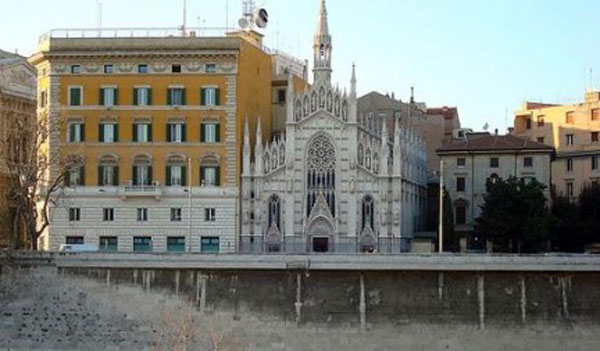
Chiesa del Sacro Cuore del Suffragio
Lungotevere Prati 12, Rome

Posted November 21, 2011
There is no great difficulty in explaining how the souls of the dead (whether blessed in Heaven, suffering in Purgatory or damned in Hell) can appear in bodily form on earth. The Church teaches that, with God’s permission, a spirit can assume some material substance in order to represent itself to the human eye, whether that substance be a body or light rays or some kind of cloud or vapor. (1)

Inside the Church of the Sacred Heart of Suffrage in Rome
What the Church prohibits is to try to enter into contact with the souls of the dead, as Deuteronomy warns us: Let no one be found among you who practices divination or sorcery, interprets omens, engages in witchcraft or casts spells, or who is a medium or spiritist or who consults the dead. (18:10-11) The Church teaches us that, under these circumstances, the Devil – also a pure spirit – can take on bodily forms in order to deceive those who follow such practices. Because it is so easy to be fooled, the faithful must exercise extreme caution in any matter dealing with apparitions of spirits or invoking them to appear.
In my last article, I promised to continue the tour of the Small Museum of Poor Souls on the Lungotevere neighborhood in the Prati section of the street that runs parallel to the Tiber. So let me fulfill my promise by looking at several more interesting exhibits.
A handprint burned into wood
One of the most impressive exhibits is a rectangular slab of wood that displays two burn marks - a scorched hand mark and a sign of the cross. These marks were left on a small wooden table by the deceased Fr. Panzini, former Abbot on the Benedictine Olivetan Order in Mantua. On November 1, 1731, Fr. Panzini appeared to Ven. Mother Isabella Fornari, Abbess of the Poor Clares Monastery of St. Francis in Todi as she sat at her work desk. He told her he was suffering in Purgatory.

The handprint and cross left by Fr. Panzini
The Abbess reported this visit to her confessor, Fr. Isidoro Gazata, a Holy Cross father. He wrote a report and ordered her to cut from her tunic and chemise the parts where the burn marks were made and to give them to him to keep. He also preserved the tabletop with the scorched hand mark and cross. These artifacts were examined by theologians and other experts of the Diocese, and determined to be of supernatural origin.
When Fr. Victor Jouet began his search at the beginning of the 20th century to find evidence of vestiges left by the Poor Souls in Purgatory, the Monastery gave him all of these relics, which were duly authenticated and are now displayed in the Small Museum. This collection, as I noted in my previous article, was part of the legacy he left his Order of the Sacred Heart of Suffrage, which was founded with the aim of spreading the devotion to the Sacred Heart as a source of help to the souls in Purgatory, according to the revelations of St. Margaret Mary Alacoque.
Expiation for her lack of patience
On the night of June 5, 1894, the deceased Sister Maria of St. Louis Gonzaga, known for her piety, appeared to Sister Margherita, another nun in Poor Clares Convent of St. Clare in Bastia, Perugia. To the surprise of Sister Margherita, Sister Maria said that she was in Purgatory.

A close up of the scorch mark left on Sister Margherita's pillow
It was that same night that she appeared to Sister Margherita dressed in her Poor Clare habit. Although the atmosphere around her was hazy, Sister Margherita could recognize her. Sister Maria told her that she was in Purgatory to expiate for her lack of patience in accepting God’s will, and she asked for prayers.
As a proof of her apparition, she placed her forefinger on the pillow of Sister Margherita, leaving a scorch mark, and promised to return. In fact, she appeared again to the same nun on June 20 and 25 to thank her for her prayers and to tell her she would be released from Purgatory. She also offered some spiritual advice for the community.
Fingerprints on a prayer book

Three finger prints burned into the prayer book cover of Maria Zaganti
Palmira left proof of her appearance by touching the cover of Maria's prayer book. Three scorched finger marks can be seen on it.
A place of fire and expiation
What is clear from these examples is there is a fire in Purgatory, as in Hell. But in Purgatory, the soul suffers with perfect resignation, knowing that it is heading to Heaven. Anna Katharina Emmerick (d.1824) had frequent contacts with poor souls. Describing one of her visits to Purgatory, she said:
“It is touching to see the Poor Souls so quiet and sad. Yet their faces reveal that they have joy in their hearts, because of their recollection of God's loving mercy. On a glorious throne, I saw the Blessed Virgin, more beautiful than I had ever beheld her. She said: ‘I entreat you to instruct people to pray for the Suffering Souls in Purgatory, for they certainly will pray much for us out of gratitude. Prayer for these holy souls is very pleasing to God because it enables them to see Him sooner.’”
From these examples, we see that God permitted certain Suffering Souls to return to earth to ask for prayers and Masses to be said for their souls so that they might receive relief in their sufferings and end their time of expiation sooner. Surely this should stimulate us to help the Poor Souls in Purgatory, especially in these days of crisis in the Church when they are so forgotten.
- Cf. St. Thomas Aquinas, Summa Theologica, I, q.51, a.2, ad.3, in Antonio Royo Marin, The Theology of Christian Perfection, p. 579-580.Martin Luther

Chiesa del Sacro Cuore del Suffragio
Lungotevere Prati 12, Rome

Posted November 21, 2011
______________________
______________________




